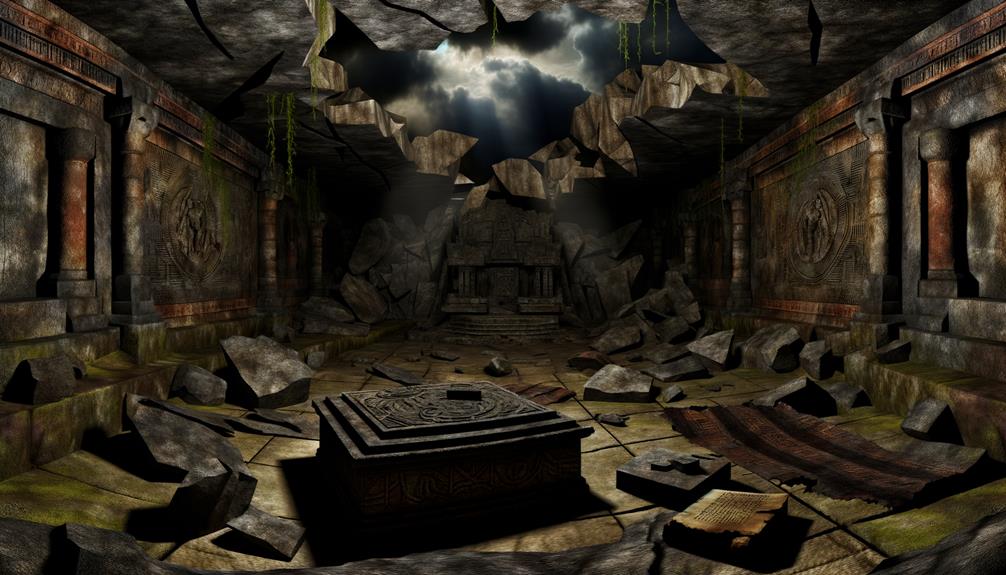Meaning of Abomination of Desolation in the Bible: Explain
The ‘Abomination of Desolation‘ in the Bible refers to a defiling act of sacrilege that precipitates severe tribulation and divine judgment. Rooted in Daniel’s prophecies, it symbolizes the desecration of sacred spaces, particularly the Jewish Temple, by foreign powers.
Jesus refers to this concept in the Gospels, foreshadowing Jerusalem’s destruction and amplifying its prophetic and eschatological significance. This term serves as a historical and theological marker, encapsulating themes of divine retribution, end-time warning, and the need for spiritual vigilance.
Exploring its implications reveals deeper insights into biblical prophecy and the continuity of divine themes across scriptures.

Abomination of Desolation in the Bible: Meaning and Prophetic Significance
| Aspect | Meaning |
|---|---|
| Biblical Term | Abomination of Desolation |
| Origin | Found in Daniel, Matthew, and Mark |
| Key Verse | Matthew 24:15 – “spoken of by Daniel the prophet” |
| Meaning | A defilement of the holy place signaling great tribulation |
| Prophetic Significance | Symbol of ultimate rebellion and a sign of the end times |
| Spiritual Insight | A call for discernment, faithfulness, and readiness in last days |
Biblical References

The term ‘Abomination of Desolation‘ appears primarily in the biblical books of Daniel, Matthew, and Mark, where it signifies a defiling sacrilege that portends great tribulation and divine judgment.
In Daniel, this concept is linked to the desecration of the temple, with prophetic undertones that suggest impending calamity.
The Gospels of Matthew and Mark later echo Daniel’s warning, as Jesus refers to it while predicting the destruction of Jerusalem.
These references intertwine apocalyptic literature with eschatological teachings, underscoring a theological framework where sacrilege leads to divine retribution.
The repeated mention across these texts highlights its critical role in understanding biblical prophecy and the anticipated fulfillment of end-time events.
Historical Context

Understanding the historical context of the ‘Abomination of Desolation‘ necessitates an examination of ancient Jewish prophecies, particularly those found in the Book of Daniel.
The influence of the Roman Empire, especially during the periods of temple desecration and destruction, further illuminates the term’s significance.
These events not only fulfilled prophetic visions but also reshaped theological interpretations within early Jewish and Christian communities.
Ancient Jewish Prophecies
Rooted in the apocalyptic visions of Daniel, the concept of the ‘Abomination of Desolation’ emerges as a profound symbol within ancient Jewish prophecies. This enigmatic phrase appears in Daniel 9:27, 11:31, and 12:11, signifying a desecration that provokes divine wrath.
Theologically, it denotes:
- Temple Defilement: The prophecy foretells an event where sacred spaces are violated, disrupting worship and covenantal fidelity.
- Political Intrusion: It reflects periods when foreign powers impose their authority, undermining Jewish autonomy and religious practices.
- Eschatological Warning: It serves as a harbinger of end-times, urging vigilance and faithfulness amidst tribulation.
Understanding these dimensions provides a thorough grasp of its historical and spiritual significance within Jewish eschatology.
Roman Empire Influence
Roman occupation of Judea profoundly impacted the interpretation and significance of the ‘Abomination of Desolation‘ within early Christian and Jewish thought.
The imposition of Roman political and military authority was seen as a fulfillment of prophetic warnings, particularly those found in Daniel. This period of domination heightened eschatological expectations and fears, especially as Roman practices and symbols were perceived as desecrations of sacred Jewish spaces.
Theological reflections during this era often viewed Roman emperors and their idolatrous practices as embodiments of the ‘abomination,’ thereby deepening the sense of divine judgment and impending deliverance.
This context reshaped the apocalyptic visions of early Christians, who linked these events to the anticipated return of Christ and the ultimate restoration of divine order.
Temple Destruction Events
The destruction of the Second Temple in 70 CE by the Roman forces profoundly altered the theological landscape, prompting early Christians and Jews to reinterpret prophetic texts concerning the ‘Abomination of Desolation’ and its eschatological implications. This catastrophic event led to significant shifts in religious thought and practice:
- Reinterpretation of Prophecy: The destruction was seen as a fulfillment of Daniel’s prophecy, urging new interpretations among believers.
- Shift in Worship Practices: Without a central temple, Jewish worship practices adapted, emphasizing synagogues and rabbinical teachings.
- Christian Eschatology: Early Christians viewed the event as a precursor to the imminent return of Christ, shaping their eschatological expectations.
These responses underscore the profound impact of the temple’s destruction on both Jewish and Christian theologies.
Daniel’s Prophecies

Daniel’s prophecies, particularly the vision of the seventy weeks, provide a profound theological framework for understanding the abomination of desolation.
The desecration by Antiochus Epiphanes serves as a critical historical precedent, offering insights into past fulfillment and informing future eschatological speculations.
These elements collectively underscore the multifaceted nature of prophetic literature and its implications for both historical and future contexts.
Vision of Seventy Weeks
Interpreting the Vision of Seventy Weeks necessitates a deep understanding of its eschatological significance and its essential role within Daniel’s broader prophetic narrative. This prophecy, found in Daniel 9:24-27, outlines a divine timetable for the restoration of Israel and the ultimate culmination of salvation history.
The seventy weeks are generally understood to represent a period of 490 years, divided into three distinct phases:
- Seven Weeks (49 years): Rebuilding of Jerusalem.
- Sixty-two Weeks (434 years): Time span leading to the arrival of the Anointed One.
- Final Week (7 years): Events leading to the end of transgressions and bringing in everlasting righteousness.
This vision is vital for contextualizing the Abomination of Desolation within a framework of Messianic fulfillment.
Antiochus Epiphanes’ Desecration
Antiochus Epiphanes’ desecration of the Jewish Temple, as foretold in Daniel’s prophecies, serves as a critical historical and theological precursor to the concept of the Abomination of Desolation.
In 167 BCE, Antiochus IV Epiphanes erected an altar to Zeus in the Jewish Temple, sacrificing swine and thereby defiling the sacred site. This act, described in Daniel 11:31, epitomized the ultimate sacrilege against the Hebrew faith and catalyzed the Maccabean Revolt.
Theologically, this desecration is viewed as a typological foreshadowing of future abominations, illustrating a recurring theme of divine sanctuaries being profaned.
Understanding Antiochus’ actions provides essential context for interpreting the broader biblical narrative concerning divine judgment and eschatological prophecy.
Future Fulfillment Speculations
The typological significance of Antiochus Epiphanes’ actions sets the stage for understanding the prophetic implications of future abominations as described in Daniel’s visions. These visions suggest a recurrence of desolation events, potentially fulfilled in eschatological contexts.
Scholars speculate on several key elements:
- Antichrist Figure: A future ruler who mirrors Antiochus’ blasphemous acts and desecrates a holy place.
- Temple Rebuilding: Some interpret Daniel’s prophecies as implying a future rebuilt temple in Jerusalem as a focal point for this abomination.
- End-Time Tribulation: A period of unparalleled distress, aligning with Jesus’ reference to Daniel in Matthew 24:15, indicating a future manifestation.
These interpretations invite theological reflection on the convergence of historical typology and future prophecy.
Gospel Accounts

Gospel accounts of the ‘Abomination of Desolation‘ primarily appear in the Synoptic Gospels, where Jesus references this enigmatic prophecy in the context of the coming destruction of Jerusalem and the end times.
In Matthew 24:15, Mark 13:14, and Luke 21:20, Jesus warns his disciples to recognize the sign, drawing directly from Daniel’s apocalyptic vision.
Theologically, this reference underscores the urgency and severity of the impending tribulations.
Contextually, it situates Jesus’ prophecy within the broader narrative of divine judgment and redemption.
These passages serve as a pivotal point for theological reflection, urging believers to discern the signs of the times and remain steadfast in faith amidst turmoil, aligning with the eschatological themes pervasive in early Christian thought.
Interpretations Over Time

Scholarly interpretations of the ‘Abomination of Desolation’ have evolved considerably over centuries, reflecting diverse theological, historical, and eschatological perspectives.
Initially, early Church Fathers linked the prophecy to the desecration of the Second Temple by Antiochus IV Epiphanes in 167 BCE. During the Middle Ages, theologians like Thomas Aquinas expanded its application to future events, often tying it to apocalyptic visions.
In modern scholarship, three primary interpretations have emerged:
- Historical-Critical Approach: Focuses on the immediate historical context, often identifying the term with specific historical events.
- Futurist Perspective: Views it as a prophecy still awaiting fulfillment in an eschatological context.
- Typological Interpretation: Suggests recurring patterns of desecration throughout history, symbolizing ongoing spiritual battles.
These interpretations illustrate the term’s complex and multifaceted nature.
Theological Significance

Understanding the theological significance of the ‘Abomination of Desolation‘ necessitates an exploration of its implications for faith, doctrine, and eschatology within various Christian traditions.
In prophetic literature, it signals profound desecration and tribulation, often interpreted as a harbinger of divine judgment.
Theologically, this concept underscores the gravity of apostasy and the seriousness with which God views idolatry and sacrilege.
It serves as a pivotal element in eschatological frameworks, particularly in premillennial and dispensational interpretations, where it is seen as a precursor to the end times.
For believers, it acts as a somber warning to maintain spiritual vigilance and fidelity.
Consequently, the ‘Abomination of Desolation’ deeply intertwines with doctrinal teachings about purity, devotion, and the ultimate fulfillment of divine prophecy.
Modern Implications

In contemporary Christian thought, the ‘Abomination of Desolation’ continues to resonate as a symbol of spiritual crisis and moral deterioration, prompting believers to reflect on its relevance to present-day faith and societal challenges.
This concept can be analyzed through several modern implications:
- Secularization: The increasing secularization of society may be viewed as a contemporary ‘abomination,’ diverting attention from spiritual values.
- Ethical Decline: Instances of widespread moral decay, such as corruption and injustice, could be interpreted as signs of desolation.
- Cultural Shifts: Rapid cultural changes that undermine traditional Christian beliefs might be seen as modern parallels to the original biblical warning.
These perspectives offer a framework for understanding the enduring impact of this profound biblical symbol.
Conclusion
The phrase ‘abomination of desolation‘ encapsulates a profound theological warning, historically rooted in Daniel’s prophecies and echoed in the Gospels.
The desecration of the Second Temple by Antiochus IV serves as a poignant metaphor, illustrating the peril of defiling sacred spaces and divine commandments.
Throughout time, interpretations have evolved, yet the core message remains: vigilance against moral and spiritual corruption is imperative.
This enduring concept continues to resonate, urging contemporary reflection on sanctity and ethical conduct.






